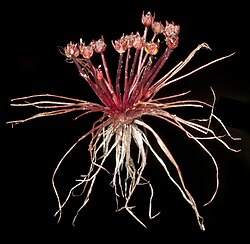| Trithuria submersa | |
|---|---|
 | |
| Complete flowering Trithuria submersa specimen | |
| Scientific classification | |
| Kingdom: | Plantae |
| Clade: | Tracheophytes |
| Clade: | Angiosperms |
| Order: | Nymphaeales |
| Family: | Hydatellaceae |
| Genus: | Trithuria |
| Section: | Trithuria sect. Trithuria |
| Species: | T. submersa |
| Binomial name | |
| Trithuria submersa | |
 | |
| Trithuria submersa is endemic to Australia [1] | |
| Synonyms [1] | |
Juncella submersa (Hook.f.) Hieron. | |
Trithuria submersa is a species of plant in the family Hydatellaceae endemic to the Australian states New South Wales, South Australia, Tasmania, Victoria, and Western Australia. [1]
